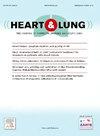Blood urea nitrogen-to-left ventricular ejection fraction ratio as a prognostic indicator in non-ST-elevation myocardial infarction: Clinical utility as a mortality marker
IF 2.6
4区 医学
Q2 CARDIAC & CARDIOVASCULAR SYSTEMS
引用次数: 0
Abstract
Background
Non-ST-elevation myocardial infarction (NSTEMI) accounts for the majority of acute coronary syndromes, and accurate early risk stratification is essential for guiding clinical management. Traditional scoring systems are complex and may not be feasible in emergency settings. The blood urea nitrogen-to-left ventricular ejection fraction ratio (BUN/LVEF) has recently been proposed as a simple biomarker reflecting the interaction between cardiac and renal function.
Objectives
This study aimed to evaluate the prognostic value of BUN/LVEF in predicting 30-day all-cause mortality in patients with NSTEMI.
Methods
We conducted a retrospective observational study including 222 patients diagnosed with NSTEMI who presented to the emergency department of a tertiary university hospital between April 2024 and April 2025. Demographic, clinical, laboratory, and echocardiographic data were collected from hospital records. BUN/LVEF was calculated as BUN (mg/dL)/LVEF (%). Receiver operating characteristic (ROC) analysis was used to assess predictive performance.
Results
The median age was 61 years, and 70.3 % were male. The 30-day mortality rate was 13 %. Non-survivors had significantly higher BUN/LVEF compared with survivors (1.48 vs 0.64, p < 0.001). ROC analysis revealed that BUN/LVEF had an AUC of 0.802 for predicting mortality. A cutoff value of 1.465 provided 93.3 % sensitivity, 51.7 % specificity, and 87.8 % overall diagnostic accuracy.
Conclusion
BUN/LVEF is a simple, accessible, and independent predictor of short-term mortality in NSTEMI patients. Its ease of calculation and strong prognostic performance suggest potential clinical utility as a rapid risk stratification tool in emergency practice.
血尿素氮与左心室射血分数比值作为非st段抬高型心肌梗死的预后指标:作为死亡率指标的临床应用
背景:非st段抬高型心肌梗死(NSTEMI)在急性冠状动脉综合征中占多数,准确的早期风险分层对指导临床治疗至关重要。传统的评分系统很复杂,在紧急情况下可能不可行。血液尿素氮与左心室射血分数比(BUN/LVEF)最近被提出作为反映心脏和肾脏功能相互作用的简单生物标志物。目的:本研究旨在评估BUN/LVEF在预测NSTEMI患者30天全因死亡率中的预后价值。方法:我们进行了一项回顾性观察研究,纳入了2024年4月至2025年4月在某三级大学医院急诊科就诊的222例确诊为NSTEMI的患者。从医院记录中收集人口统计、临床、实验室和超声心动图数据。BUN/LVEF计算为BUN (mg/dL)/LVEF(%)。采用受试者工作特征(ROC)分析评估预测效果。结果:中位年龄61岁,男性占70.3%。30天死亡率为13%。与幸存者相比,非幸存者的BUN/LVEF明显更高(1.48 vs 0.64, p < 0.001)。ROC分析显示,BUN/LVEF预测死亡率的AUC为0.802。截断值为1.465,灵敏度为93.3%,特异性为51.7%,总体诊断准确率为87.8%。结论:BUN/LVEF是NSTEMI患者短期死亡率的一个简单、可及且独立的预测指标。其易于计算和强大的预后性能表明潜在的临床应用,作为一个快速的风险分层工具在急诊实践。
本文章由计算机程序翻译,如有差异,请以英文原文为准。
求助全文
约1分钟内获得全文
求助全文
来源期刊

Heart & Lung
医学-呼吸系统
CiteScore
4.60
自引率
3.60%
发文量
184
审稿时长
35 days
期刊介绍:
Heart & Lung: The Journal of Cardiopulmonary and Acute Care, the official publication of The American Association of Heart Failure Nurses, presents original, peer-reviewed articles on techniques, advances, investigations, and observations related to the care of patients with acute and critical illness and patients with chronic cardiac or pulmonary disorders.
The Journal''s acute care articles focus on the care of hospitalized patients, including those in the critical and acute care settings. Because most patients who are hospitalized in acute and critical care settings have chronic conditions, we are also interested in the chronically critically ill, the care of patients with chronic cardiopulmonary disorders, their rehabilitation, and disease prevention. The Journal''s heart failure articles focus on all aspects of the care of patients with this condition. Manuscripts that are relevant to populations across the human lifespan are welcome.
 求助内容:
求助内容: 应助结果提醒方式:
应助结果提醒方式:


